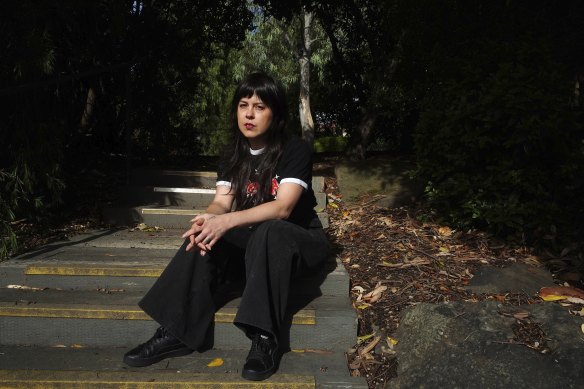By Jim Malo and Courtney Kruk
On hot days, Natasha Ritchie prefers to turn on the air-conditioning and avoid leaving the house.
But given the cost-of-living crisis, one of her favoured coping strategies is becoming further out of reach.
“I try not to use [air-conditioning] too much and at times when it is cheaper to run,” she said. “But it’s not possible when it’s extremely hot … the heat can make it really hard to concentrate while I’m working from home or trying to sleep.”

The high cost of running air conditioning was of concern to Ritchie. Credit: Luis Ascui
Ritchie rents in inner Melbourne, but it is Queenslanders who have the highest cost-of-living concerns related to air-conditioning expenses nationally, according to the latest Sweltering Cities Summer Survey Report.
Two in three Queenslanders who have an air-conditioner say concerns about the cost of running it prevent them from turning it on.
More than 2300 Australians shared their experiences of living with high temperatures and heatwaves for the Sweltering Cities survey, including 441 Queenslanders.
Participants were asked: Do you feel unwell during heatwaves or on hot days? Do you have air-conditioning? If so, do concerns about cost stop you turning it on?
Overall, 68 per cent of respondents said they felt unwell on hot days or during heatwaves. NSW and Victorian residents reported similar rates of discomfort at 67.8 per cent and 65.5 per cent respectively.
But the discomfort level was much higher in Queensland, where 74.1 per cent of participants said they felt unwell on hot days.
One Brisbane respondent said they get “cranky and depressed” in humid weather. Another described “brain fog” and swollen legs: “I slow right down, become very unproductive, and struggle to do much,” they said.
A recent report from tenant advocacy organisation Better Renting found renters across Australia experienced unlivable indoor temperatures last summer, with Queensland the hottest state.
Data from the Cruel Summers report found the median indoor temperature in Queensland rental homes was above 28.2 degrees, 50 per cent of the time, with an average humidity of 64.4 per cent.
“Queensland was hands-down the hottest state we saw in our data from rental researchers,” Better Renting executive director Joel Dignam said.
“I know people in Queensland are a bit used to hotter weather, but there’s no getting used to that.
“[It’s] an awful situation to be living through, particularly when you also have high average humidity.”
Better Renting project officer Sabrina Clarke said the effects of extreme heat can “ripple out through a person’s life”.
“You can’t get any sleep because your home is too hot overnight. You’re exhausted, you’re fatigued, you don’t want to cook at home because of the heat, you don’t want to have friends over because you know your home isn’t a nice place to be,” she said.
“Fear of the next electricity bill is creating even more stress.”
Ritchie said using air-conditioning was key to managing her endometriosis symptoms during hot days because her main strategy to deal with flare-ups, a heat pack, became unusable.
“In summer that’s quite hard to target the pain in that way,” she said.
“I feel like I’m about to pass out and I can’t get good sleep. If I can stay home I will, but that won’t always mean it’s the best time for me.”
Currently, only the ACT and Victoria have minimum rental standards related to energy performance, with Victoria planning to expand existing standards this year to cover ceiling insulation and cooling appliances. Better Renting has called on the Queensland government to follow suit.